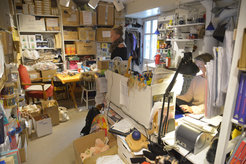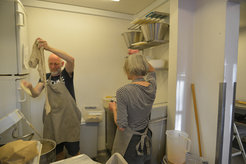The importance of sameness
Author: Anne Erita Venåsen Berta
October 12, 2016
It is a regular day in the business. Two employees, the owner and the anthropologist are sitting in the lunchroom. The owner and one of the employees are discussing orders, and a third one is there just to have a cigarette. The door opens and another employee from the shop floor lets in a tall, young man. All of us look up at the young man. He introduces himself in English. He has just arrived from the USA and he is looking for work. He tells us that he is willing to do anything and can work as much or as little as needed. He smiles and seems nice. The owner, who speaks fluent English, rejects him instantly. We are not looking for new employees and we don’t need any help, the owner tells him. The man leaves, and everybody goes back to what they were doing when the young man interrupted. I am confused. One of the employees had just resigned in the busiest period of the year, and we could definitely have used an extra hand. When I asked the owner why he was so quick to reject this person, who to me seemed like a nice man, the owner explained to me that he simply would not have fitted in here, he didn’t even speak Danish. This case illustrates a pattern I recognised several times both in the business and in my informants’ private lives: the importance of fitting in and of sameness.
The Norwegian anthropologist Marianne Gullestad has described the Scandinavian principle of equality as sameness. According to her, Scandinavians are obsessed with equality. Equality in this sense, however, does not refer to egalitarianism and the lack of social hierarchy. It refers to an implicit social model where people avoid establishing social relationships with people who they view as different from themselves. In her monograph, Kitchen Table Society (1984), Gullestad describes how working class women in the suburbs of Bergen, one of Norway’s largest cities, were careful only to socialise with people who they can identify as the same as themselves, judged by jargon, the inventory of their houses, the cleanness and tidiness of their flats, economic status, and so forth. Gullestad thus found that in order for a social relationship to be successful, it was important for the different actors involved that the people they interacted with were perceived as the same. Since she first published her theories, many other ethnographers of Scandinavia have found what may be referred to as the (Scandinavian) principle of sameness (see ex:Bruun, Jakobsen, and Krøijer 2011). Gullestad’s (1984) analysis of these women reflects a kind of morality that has been discussed by Hastrup and Löfgren (1992) as essential in Scandinavian society. They refer to the concept of Janteloven: a moral principle guiding us to be careful not to demonstrate our success or to believe that it will last forever. Hastrup and Löfgren (1992) argue that this ideology of equality demonstrates continuity with peasant society, more specifically a Nordic modesty against trumpeting your own luck or happiness. Showing off wealth or acting in an arrogant manner is frowned upon. We should not show that we are unequal, even if we are. I will show that these values of sameness and modesty are present also in my field. I will argue that Gullestad’s concept of ‘equality as sameness’ appears to be among the core values of the business owners in a Danish family business.
The firm, let’s call it Ikan1, is a family business in what the locals referred to as the ‘traditional sense’. It had been handed down from father to son and survived way beyond the grandson generation. In 2016 it has around 30 employees, including part-time and seasonal workers, and is among the largest of its kind both in terms of square meters and sales. For the CEO, it is important continuously to perform his role as equal and ‘the same’ as his employees. This is permanently demonstrated by merging his office with the lunch room. Every time the employees go to have a snack, coffee, a cigarette or their lunch break, he is sitting in the lunch room continuously reminding them that he is their equal. He is so much their equal that he does not even bother to have a separate office. Simultaneously, his perpetual presence reminds them that in fact he is not the same as them. He does not perform the same work tasks as them, although he has done so in the past, and he occasionally does so now; he is their superior. By constantly maintaining his presence in the lunch room, he reminds the employees that his work is different from theirs. His job is to make sure that the store downstairs has all the goods it needs at all times. His job is also to monitor the activities in the store, and he decides whether or not they can take special orders. This resembles what Gullestad (1984, 95) calls an implicit model of society, which ‘expresses a tension in the culture between ideas of equality and the hierarchies of division of work’.

This tension is exactly what is visualised in the CEOs attempt to perform his sameness. By sharing his office with all the employees, he makes a statement that he requires no more than them in order to do his job. He dresses informally in the same uniform as them (except for a fleece jacket which he wears every day through the autumn and winter months), eats with them, drinks coffee with them and chats with them just like they talk with each other. He told me repeatedly during my stay that he was just like everyone else and that he felt no need to show off his power or wealth to anyone. On the contrary, it was important for him that everybody knew that up until recently he had done the same work as them for 18 hours a day every day since he was a teenager. It was only because of an injury that he was not working together with them on the shop floor anymore. Despite the owner’s informal wardrobe and his social levelling, from the employees’ perspective they were not the same at all. In their eyes, the owner had a comfortable workday sitting in a warm room smoking cigarettes, drinking coffee and chatting. They did not see the amount of work he did everyday on his phone. In their eyes he was there just to chat with them, and they did not realise that most of his work was done over the phone, almost invisible to them. They assumed that he was just texting his friends and reading the news online. Nor were they aware that his day starts at 2-3am in the morning when he wakes up to get a good deal at the daily auctions.

He differs from them when he arrives in his DKK 1.5 million car (€200,000), but that is it as far as visible difference is concerned. The owner is also very careful to mention that his car is the only luxury he allows himself. In all other aspects of life, although he can afford it, he claims not to be greedy. The owner and the employees use more or less the same jargon, share the same socio-economical background, and mainly the same moral values. This is probably due to the fact that the current owner and his wife have – despite being the daughter and son in law of the former owner – worked their way up. Although they are now the owners and in full control of the business, they have been workers all their lives until eight years ago, when they took over the business. Previously they were hard workers with no more social or economic capital than their employees. The daughter of the former owner grew up with her mother – a single mother – and had had to work outside the home since she was 13. Her husband too came from a working family and also started working as a teenager. They have no formal education relevant to their work, but what made them able to run the company was their passion for their products, their life-long involvement in this particular business and their hardworking spirit. In their social, moral, and physical presence, or as they might say – in their heart, mind, and soul – they are workers, and always will be.
Although I am drawing on one example from one business, I found that all the businesses I visited during my time in the field shared these principles of sameness and social hierarchy. All except for one of the small firms I visited merged the owners’ office with the common lunch room, all proprietors had worked their way up in one way or the other, and all spent a lot of energy convincing the employees that they were the same as them. Simultaneously, despite the owners’ efforts to perform their sameness, in the eyes of the employees there was a clear difference. In most cases, the employees failed to recognise the enormous amount of work the owners put into the business.
Note
References
Bruun, Maja Hojer, Gry Skrædderdal Jakobsen, and Stine Krøijer. 2011. "Introduction: The Concern for Sociality—Practicing Equality and Hierarchy in Denmark." Social Analysis 55 (2):1-19.
Gullestad, Marianne. 1984. Kitchen Table Society: A case study of the family life and friendships of young working-class mothers in urban Norway. Oslo, Bergen, Stavanger, Tromsø: Universitetsforlaget.
Hastrup, Kirsten, and Orvar Löfgren. 1992. "Lykkens økonomi." In Den nordiske verden edited by Kirsten Hastrup, 240-257. Copenhagen: Gyldendal.

